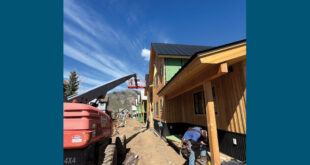Unused gas from one mine could heat 39,000 homes
The Gunnison Board of County Commissioners agreed to amend the North Fork Special Area Regulations to allow for the capture and use of coal bed methane that is now being released into the atmosphere.
The amendment will be the latest step in an effort to deregulate the collection of methane released during the coal mining process for electricity generation and other types of fuel.
“We actually need to amend our Special Geographic Area [regulations], because they exclude gas collection,” county manager Matthew Birnie said. “That [amendment] is in the process.”
All of the methane, or natural gas, being released from the three coal mines in the North Fork Valley is being vented away from the mine face, because it would be harmful to miners. A small amount is being collected to generate electricity to run the venting vacuum pumps. The rest is vented unused into the atmosphere.
But due to a growing awareness of climate change, there is an effort to stop the release of methane, which has 23 times the heat-trapping capacity of carbon dioxide. Reducing the amount of greenhouse gas emissions released in the county is a stated goal of the commissioners.
“It’s well documented that this board is very sympathetic to your cause,” commissioner Hap Channell told Steve Wolcott, chairman of the Western Slope Environmental Resource Council’s (WSERC) coal committee, who gave a presentation on coal bed methane capture to the commissioners Tuesday, March 24.
“We’ve been asking about methane capture for years and I think we’re all glad to see it getting to the point where this methane can be put to good use,” Channell said.
As recently as January, the Bureau of Land Management, which controls the gas and mineral leases in the North Fork Valley, would not allow methane to be captured to generate revenue, although it could be used for on-site electricity generation.
Wolcott told the commissioners, “Mountain Coal Company, which is the operator of the West Elk Mine, and WSERC had been pressuring the BLM about the restrictions and in January the BLM amended Mountain Coal’s existing coal leases to allow capture and use of the gas.”
Now, the BLM is attaching a permit to collect methane to every coal permit and, if the collection is shown to be “safe and economically feasible,” charging a royalty on the gas if it is used or not, according to Wolcott.
The final hurdle to easing regulations toward methane capture and use is getting the BLM to finalize an official definition for “economically feasible,” so companies know if they have to pay the royalty.
“Paying the royalty might make capturing methane more attractive to companies, since they’ll have to pay whether they use it or not, especially if they release as much gas as the West Elk Mine,” Wolcott said.
The West Elk Mine, located in Paonia, vents as much as seven million cubic feet of methane each day, most of which comes from a layer of sandstone above the coal seam that fractures during mining and releases the gas, he said.
According to Gunnison Energy Corp, which holds gas leases on 100,000 acres on the Western Slope, that much methane is equivalent to the amount of natural gas produced by 45 typical gas wells and is consistently enough to heat all of the homes in a city twice the size of Grand Junction.
Wolcott said the amount of energy contained in the methane being released in the North Fork Valley could be underestimated because it is a higher concentration than what is used commercially.
“They’re getting 50 to 70 percent pure methane, which is a higher concentration than what is needed to use. We would have to dilute it with air before it could be used. That could actually mean there is more marketable gas than is being vented,” he said.
Wolcott said there are a couple of remaining barriers to the widespread use of methane for electricity generation, including the regulatory ones that are being worked out by the BLM, contracts with utilities, like Tri-State, that restrict the amount of electricity that can be generated on-site, and transport issues.
“There has to be a way to make the methane marketable, either through electricity that can be pumped back into the grid or as natural gas going to market,” Wolcott said. “The hope is to use the West Elk Mine to set a precedent that can be used to encourage methane capture around the country—someday, maybe at every mine in the country.”
 The Crested Butte News Serving the Gunnison Valley since 1999
The Crested Butte News Serving the Gunnison Valley since 1999

